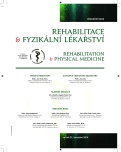-
Medical journals
- Career
Botulinum Toxin for the Treatment Muscle Overactivity at Spastic Paresis Belong also in Hand at Rehabilitation Medical Specialists
Authors: M. Kövári 1; M. Hoskovcová 2; R. Jech 2
Authors‘ workplace: Klinika rehabilitace a tělovýchovného lékařství 2. LF UK a FN Motol, Praha, přednosta prof. PaedDr. P. Kolář, Ph. D. 1; Neurologická klinika a Centrum klinických neurověd 1. LF UK a VFN, Praha, přednosta prof. MUDr. E. Růžička, DrSc. 2
Published in: Rehabil. fyz. Lék., 21, 2014, No. 4, pp. 224-226.
Category: Review Article
Overview
Spasticity treatment has made a huge step forward in the recent years. One of the options for selected neurological diagnoses is the application of botulinum toxin. The SPC now allows even the physiatrists /rehabilitation medical specialists/ to apply botulinum toxin to patients with these selected diagnoses. At this time application of botulinum toxin is the domain of neurologists in complex or regional spasticity centres. However, it is desirable for the number of centers to increase; and for the maximalization of the effect of this costly therapy, a thorough theoretical and practical training of physicians (even physiatrists) is necessary.
Keywords:
muscle overactivity, spastic paresis, botulinum toxin, guided self-rehabilitation contract, spasticity centers
Sources
1. BRASHEAR, A., GORDON, M. et al: Intramuscular injection of botulinum toxin for the treatment of wrist and finger spasticity after stroke. New England J. Med., 347, 2002, 6, s. 335-400.
2. EHLER, E.: Současná terapie spasticity se zaměřením na lokální aplikaci botulotoxinu. Neurologie pro praxi, 2001, s. 128-132.
3. GRACIES, M. et al.: Five step clinical assessment in spastic paresis. European Journal of Physical Rehabil. Med., 46, 2010, 3, s. 411-421.
4. HEINEN, F. et al.: The updated European Consensus 2009 on the use of Botulinun toxin for children with cerebral palsy. European Journal of Paediatric Neurology, 2009, doi:10.1016/j.ejpn 2009.09.005.
5. MERINO, A. G.: Endocannabinoid system modulator use in everyday clinical practice in the UK and Spain. Expert Reviews Neurother., 2013, Suppl. 1, s. 9-13.
6. REICHEL, G.: Cervical dystonia: A new phenomenological classification for botulinum toxin therapy. Basal Ganglia, 1, 2011, s. 5-12.
7. SCHEJBALOVÁ, A.: Současný přístup ortopeda k operační léčbě pacientů s dětskou mozkovou obrnou. Neurologie pro praxi, 12, 2011, 4, s. 248-251.
8. ŠTĚTKÁŘOVÁ, I., EHLER, E., JECH, R. et al.: Spasticita a její léčba. Maxdorf, 2012, s. 117-151, ISBN 978-80-7345-302-2.
9. ŠTĚTKÁŘOVÁ, I., EHLER, E., JECH, R. et al.: Spasticita a její léčba, Maxdorf 2012, s. 67 – 76, ISBN 978-80-7345-302-2
10. WISSEL, J. et al.: European consensus table on the use of botulinum toxin type in adult spasticity. Journal Rehabiliton of Medicine, 41, 2009, s. 13-25.
11. www.czech-neuro.cz/rubrika/56 - Sekce-spolecnosti-Centra/index htm, Centra pro léčbu spasticity, Česká neurologická společnost.
12. Yelnik, A. P., Simon, O., Parratte, B., Gracies , J. M. et al.: How to clinically assess and treat muscle overactivity in spastic paresis. Journal of Rehabil. Med., 42, 2010, 9, s. 801-807.
Labels
Physiotherapist, university degree Rehabilitation Sports medicine
Article was published inRehabilitation & Physical Medicine

2014 Issue 4-
All articles in this issue
- Using of Mechanical Insufflation and Exsufflation in Patients with Neuromuscular Diseases
- Limbs Movement as an Indicator of Spontaneous Motor Activity at Pre-term Infants
- Czech Version of the Neck Disability Index and its Application in Patients with Neck Pain
- Electroencephalographic Correlates of the Onset of Central Fatigue During Prolonged Violin Play of Professional Musicians
- The Possibilities of Using Incremental Shuttle Walk Test in Clinical Practice and Clinical Research in Patient with Respiratory Dysfunction
- Paresis of Nervus Thoracicus Longus after Resection of the Right Rib in the Thoracic Outlet Syndrome
- Shoulder in Epitome – Second Part
- Botulinum Toxin for the Treatment Muscle Overactivity at Spastic Paresis Belong also in Hand at Rehabilitation Medical Specialists
- Uninterrupted Low-temperature Packing Therapy in the Therapy of Acute Lower Back Pains Exerting Higher Efficiency than Ibuprofen and Acetaminophen
- Concept of Castillo Morales® v Theory and Practice
- Rehabilitation & Physical Medicine
- Journal archive
- Current issue
- Online only
- About the journal
Most read in this issue- Shoulder in Epitome – Second Part
- Concept of Castillo Morales® v Theory and Practice
- Paresis of Nervus Thoracicus Longus after Resection of the Right Rib in the Thoracic Outlet Syndrome
- Czech Version of the Neck Disability Index and its Application in Patients with Neck Pain
Login#ADS_BOTTOM_SCRIPTS#Forgotten passwordEnter the email address that you registered with. We will send you instructions on how to set a new password.
- Career

